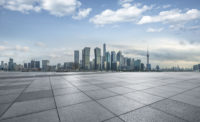
Explorative work on the search for alternative catalysts was done with regard to the yellowing tendency of amidines. During these investigations, a completely new two-stage curing mechanism was found in the presence of metal acetylacetonates as catalysts (Figure 1).(2.3) In the presence of the catalyst, the reaction between OH groups and the uretdione crosslinker gives an allophanate structure at temperatures below 150 °C. The second stage occurs at temperatures higher than 160 °C. The allophanate structure is cleaved to a urethane and a free isocyanate group, which reacts directly with further OH- groups to yield another urethane.(4.5)
The new curing route enables a new processing line for the pre-coating of metal sheets. Metal sheets that are pre-coated with a shapeable first coat or finishing layer are supposed to be a very attractive and increasing market in the future.(6) With respect to the introduction of the new European VOC guideline in 2007, the use of emission-free powder coatings in connection with slim processing lines becomes more and more attractive. Furthermore, a change in the sequence of processing steps(7) shows an enormous saving potential, e. g., replacement of production-integrated coating lines and saving of special cleaning and pickling steps. State-of-the-art pre-coating of aluminum boards or coil by using thermo-curable powder coatings has not been realized until now. The main pre-condition for the future realization is the development of highly flexible powder coatings with curing temperatures <150 °C. This temperature region is necessary in order to prevent crystallization processes and embrittlement of the aluminum substrate itself. These processes cause a significant loss of flexibility and, hence, a loss of the formability of the aluminum sheets already within curing times of less than 30 minutes depending on the temperature.(8)

Binding Agents with Low Melt Viscosity
In view of the lowering of the curing temperatures below <150 °C there is a high demand for the development of polyester resins with a low melt viscosity. This property is essential for obtaining good flow properties as well as for the increase of the reactivity of the powder coatings. In our first experiments, we started with the commercially available resin Crylcoat 240, which is used in forming stable PU powder coatings. This polyester exhibits a high melt viscosity, resulting in bad optical and mechanical film properties.In this work, in close cooperation with our industrial partner Synthopol, we developed the amorphous OH-functionalized polyester DLE 04-210. In comparison to the Crylcoat 240 this resin shows a considerable decrease of the complex melt viscosity. Figure 2 illustrates the temperature dependence of the complex melt viscosity n* of different polyesters and their corresponding powder coatings. The curve of the pure DLE 04-210 is shifted to lower values of n* compared to the Crylcoat 240. Powder coatings were prepared with the different polyesters.
The decrease in the melt viscosity of the powder coating formulations containing the new polyesters was our line of reasoning. The melting of PCF 1 sets in at 95 °C and the complex melt viscosity passes a minimum at 160 °C. In the presence of the new polyester DLE 04-210 the first minimum of n* was observed at 122 °C, indicating that the curing process sets in at lower temperatures. Furthermore, the value of n* in the minimum (418 Pa•s) is also lower, demonstrating the enhanced flow characteristics of PCF 2 during the film formation.
In order to get a further reduction of the curing temperature, the influence of semi-crystalline polyesters was studied. Due to its semi-crystalline character, the polyester Vestagon® EP-R 4030 has a sharp melting range between 110 °C and 120 °C. Therefore, the complex melt viscosity of the polyester decreased drastically at 117 °C, and was no longer measurable at higher temperatures. The semi-crystalline polyester has a decreasing influence on the melt viscosity of the powder coating formulation PCF 3. PCF 3 consist of a polyester mixture of 20 w/w per weight Vestagon EP-R 4030 and 80 w/w per weight DLE 04-210. The minimum of n* was also observed at 122 °C. But with respect to PCF 2 the value of n* in the minimum (214 Pa•s) was halved.

Furthermore, the influence of the semi-crystalline polyester was examined by practical tests. Powder coatings PCF 2 and PCF 3 were applied on degreased steel sheets and cured in a circulating air oven for 30 minutes at various temperatures. The mechanical film properties of the cured coating films were determined by impact resistance testing according to ASTM D 2794 (Table 1). Whereas at 140 °C very flexible coating films, illustrated by impact values of 160 inch•lb, were obtained for both systems, the flexibility of PCF 2 was reduced at 130 °C. For PCF 3 the curing temperature could be decreased to 120 °C with almost no loss of the flexibility.

Excellent Weathering Stability
In order to develop formable stable powder coatings for exterior applications, the weathering resistance of the coating film, in addition to its high flexibility, is of great importance. Therefore, a QUV test was carried out at AKZO Nobel Powder Coatings in Bensheim, Germany. The fluorescent lamps emit UV radiation at 313 nm that emulates the intensity of mid-day June sunlight in Florida.During the exposure tests, oxygenated water is applied to the test samples by condensation, rather than by spray. The water supply is heated in a vented tank below the test racks and lamps. To control the cyclic tests, the QUV is equipped with a variable interval timer that alternates the UV and the condensation at 43 °C followed by 8 hours UV radiation at 60 °C and high humidity.
Powder coatings PCF 3 and PCF 4 were compared to a standard PU system and a GSB (GSB International: Gütegemeinschaft für die Stückbeschichtung) certified polyester/primid system for exterior applications (Figure 3). With the exception of the PU system, the initial gloss of the examined coatings was about 90 gloss units, representing high-gloss coatings. In this test, the 50 per cent mark of residual gloss is the limiting value for the accelerated weathering. This value was undercut by the PU system after 336 h whereas the polyester/primid system reached the limiting value after approximately 550 h.
Surprisingly, the two polyallophante powder coatings, PCF 3 and PCF 4, exhibit excellent weathering stability. For both coating films almost no decrease in initial gloss was detected after 300 h. The 50 per cent mark was undercut by the PCF 4 only after 675 hours. A further improvement of weathering stability was found for PCF 3, which showed a residual gloss of 50 per cent after 879 hours.

Kinetic Analysis of Curing Behavior
The optimal curing conditions of powder coatings are usually experimentally determined, which is an extremely time-consuming procedure. In order to reduce the experimental expenditure, we carried out formal kinetic analysis of the curing process of PCF 4. Based on an appropriate formal kinetic model and the determined kinetic parameters, activation energies Ea, pre-exponential coefficients A and the reactions orders n, the curing reaction can be simulated in consideration of any time-temperature profiles.The formal kinetic analysis was carried out using the software “Thermokinetics” (Netzsch). The required data were obtained by five different non-isothermal DSC measurements with heating rates from 1.25 K/min up to 20 K/min. At the beginning of the analysis a suitable formal kinetic model as well as suitable starting parameters must be chosen. Therefore, a model-free estimation of the activation energy according to the Friedman analysis was carried out. The energy plot of the Friedman analysis gives on the one hand some information about the probable formal kinetic model; on the other hand the activation energy for every reaction step could be estimated. In the case of powder coating PCF 4, a three-step model with the reactions AkBkCkD was favored.
The kinetic parameters were determined by multivariate non-linear regression. The best fit of the experimental curves was achieved using the three-step reaction model, indicated by a correlation coefficient of 0.974 (Figure 4). In the preferred model the first reaction step AkB describes the endothermal melting of PCF 4, whereas the following two steps BkC and CkD describe the curing process of the powder coating. As the whole process is based on a formal kinetic model it is difficult and often not possible to assign the components of the model to intermediary stages or products. However, in this case component D represents the cured powder coating.



Precoated Metal Sheet Formation
Based on the kinetic evaluation of the polyallophanate powder coating PCF 3, it was found that curing conditions of 140 °C/30 minutes or 150 °C/30 minutes led to highly flexible lacquer layers. This high flexibility is the precondition for successful forming of pre-coated metal sheets e.g., by deep drawing.Prior to the deep drawing of real parts some basic forming operations were carried out. These operations included the deep drawing of Erichsen-cups or of assemblies of more complex forms. Figure 6 shows a deep-drawn “key”, which consists of different edge radii and the maximal deformation degree for aluminum. Both powder coatings PCF 3 and PCF 4 exhibited outstanding forming properties.


Conclusions
The development of new aliphatic OH-functionalized polyesters enabled the reduction of the curing temperatures of polyallophanate powder coatings. Furthermore, very flexible coating films were obtained; so it is possible to use these coatings for the pre-coating of metal sheets. A further reduction of the curing temperature and increase of the flexibility was achieved by the use of semi-crystalline polyesters.
Besides the extraordinary mechanical and optical film properties of the lacquer layers, the powder coatings exhibited excellent weathering resistance. Compared to established coating systems for exterior applications, the new polyallophanate powder coatings showed a clearly increased stability in accelerated weathering.
The curing process of the polyallophanate powder coatings was simulated based on formal kinetic analysis. The results of the predictions were verified by experimental tests. Optimal curing was carried out within 30 minutes at 140 °C or 150 °C.
Finally, forming operations of pre-coated steel and aluminum sheets expressed the high flexibility and high optical properties of the cured lacquer layers. The pre-coated sheets passed the forming tests under real processing conditions.
Acknowledgements
We would like to thank our industrial partners for outstanding cooperation and donation of raw materials. Furthermore we thank Magnetto Automotive Treuen for forming operations of pre-coated metal sheets. For financial support of this research we thank the Federal Ministry of Education, Science, Research and Technology (BMBF 01RC0163).
This paper was presented at THE WATERBORNE SYMPOSIUM sponsored by The University of Southern Mississippi School of Polymers and High Performance Materials and The Southern Society for Coatings Technology, 2008, New Orleans, LA.
Besides the extraordinary mechanical and optical film properties of the lacquer layers, the powder coatings exhibited excellent weathering resistance. Compared to established coating systems for exterior applications, the new polyallophanate powder coatings showed a clearly increased stability in accelerated weathering.
The curing process of the polyallophanate powder coatings was simulated based on formal kinetic analysis. The results of the predictions were verified by experimental tests. Optimal curing was carried out within 30 minutes at 140 °C or 150 °C.
Finally, forming operations of pre-coated steel and aluminum sheets expressed the high flexibility and high optical properties of the cured lacquer layers. The pre-coated sheets passed the forming tests under real processing conditions.
Acknowledgements
We would like to thank our industrial partners for outstanding cooperation and donation of raw materials. Furthermore we thank Magnetto Automotive Treuen for forming operations of pre-coated metal sheets. For financial support of this research we thank the Federal Ministry of Education, Science, Research and Technology (BMBF 01RC0163).
This paper was presented at THE WATERBORNE SYMPOSIUM sponsored by The University of Southern Mississippi School of Polymers and High Performance Materials and The Southern Society for Coatings Technology, 2008, New Orleans, LA.






